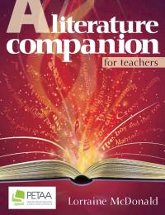A Literature Companion for Teachers by Lorraine McDonald

A Literature Companion for Teachers by Lorraine McDonald
Primary
English Teachers Association Australia, ISBN 9781875622863.
192pp., pbk RRP $A42.95 (non-members); $A32.70 (members)
In the foreword to this book, Associate Professor Alyson Simpson
says, 'A companion is someone who travels with you; a guide who has
gone before and therefore knows how to prepare you for the journey
and what to highlight on the way. This companion text shows you the
way to travel in the literary landscape, providing signposts for you
to look around with increased awareness but also stepping back so
you can make your own discoveries.' That statement perfectly sums up
this professional text which explores the English strand of the
Australian Curriculum, particularly the Literature substrand.
Starting with a section on the value of narrative for children and
young adults and the types of literary texts that our students
should encounter, the author (an academic at ACU, Sydney) shows us
how to navigate the literature requirements of the Australian
Curriculum through information, ideas, insight, examples, questions
and tasks that provide a very sound map for the journey. 'It
presents literary writing as both an 'art' and a 'craft' and
explores aspects of the 'craft' of writers' 'artistry'.' (p6)
For example, it explores the importance of the context - historical,
cultural and social - of a text so that as teachers we have that
fundamental knowledge to share with students, and this is supported
with examples of texts, suggested questions to interrogate it,
including sample responses and evidence, as well as tasks that
students could undertake to develop their own understandings.
Subsequent chapters address responding to literature, examining
literature, creating literary texts, figurative language, poetry,
reading and viewing picture books, and literature in a digital age
and each has the ACELT outcome and year level clearly referenced.
While its key focus is the literature strand, the language strand is
interwoven to enable us how to show students how literary language
constructs meaning and how literary texts provide models on which
they can build. Similarly, the tasks which focus on critical
analysis, structured conversations, close reading and guided writing
mean that the literacy strand is also prominent.
This book is going to be the basis on which the leaders of The FIRST
Book Club will base the tasks for students to complete, and
while these will be based on the outcomes for Year 5/6, it would be
an excellent platform for the program of any teacher librarian or
classroom-based teacher from K-10. It is one of the few titles
I've encountered where the contents live up to the blurb on the
back, and which won't just sit on the bookshelf unopened. It
is more than a companion - it is a valued and valuable friend, and
my copy is well-thumbed already.
Barbara Braxton